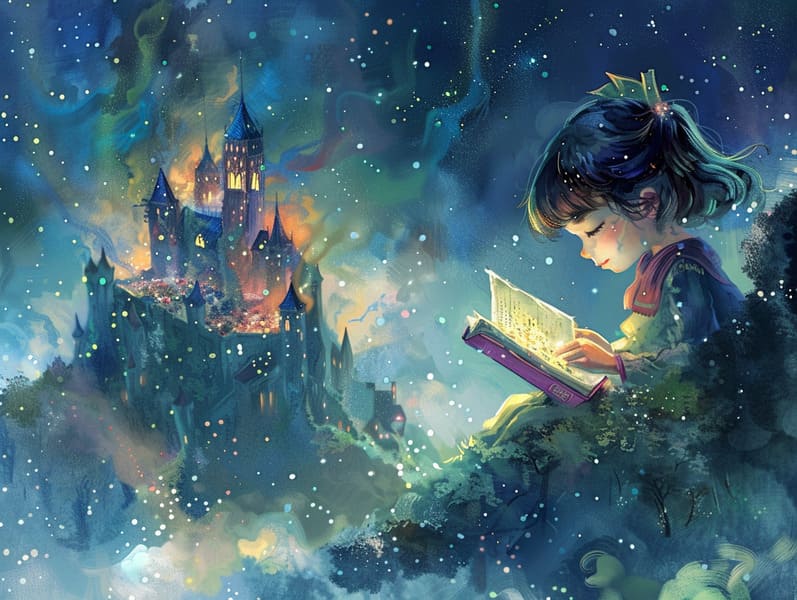
Traditional fairy tales have old origins. These stories have been whispered from one generation to the next ages before they were ever put on paper. They developed from a variety of backgrounds, including Western traditions. They were initially told among older generations, often carrying themes and messages concerning the societal norms and beliefs of the time.
The renowned Brothers Grimm, the two Grimm brothers, were among the first to compile and publish many of these beloved fairy tales. Their anthology, "Grimm's Folk Tales," included tales like "Cinderella," "The Story of Hansel and Gretel," and "Snow White," which have since become classics in the world of children's fairy tales. Similarly, Hans Andersen's delightful stories, such as "The Little Mermaid," and "The Ugly Duckling," have won hearts worldwide, ensuring their place in the pantheon of timeless fairy tales.
Despite their ancient origins, these tales remain as important as ever, especially as children's night stories. These fantastical tales are now available in diverse formats, including gorgeously illustrated books, enchanting animations, and free fairy tales online.
Their unwavering allure can be traced to several charming aspects:
Moral Lessons: Classic fairy tales often whisper important moral lessons. Tales like "The Story of the Boy Who Cried Wolf" teach the value of sincerity, while "The Tale of the Tortoise and the Hare" point out the values of tenacity and humbleness. These tales offer kids clear distinctions between moral and immoral, building their moral compass in a tender yet lasting way.
Warmth and Understanding: Traditional fairy tales frequently portray heroines facing obstacles and hardships, inspiring readers to feel with their struggles and applaud their triumphs. For instance, "The Story of Beauty and the Beast" demonstrates the merit of seeing beyond looks to perceive the inner core of a character, advancing insight and understanding.
Cultural Knowledge: Many old fairy tales are rooted in the cultural contexts from which they bloomed. Engaging with these stories can provide enlightening views into different customs, developing a sense of world appreciation and acknowledgment.
Inventiveness and Imagination: The fanciful elements in ancient fairy tales—enchanted lands—fuel children’s fantastical thinking. These narratives move readers to otherworldly realms, unleashing imaginative thinking and a sense of wonder that persists a lifetime.
Traditional fairy tales are not only charming but also didactic. They provide alluring tools in strengthening various brain and heart skills in the young. When timeless fairy tales are told out loud, they cultivate communication skills by introducing new terms and complex sentence structures. This practice also enhances listening abilities and attention, as kids stay focused, keen to see what happens next.
Furthermore, examining the themes and characters of ancient fairy tales can strengthen reasoning skills and evaluative skills. Young readers are led to detect patterns, make predictions, and realize cause and effect. These conversations also aid the young communicate their thoughts and feelings, enhancing their emotional intelligence.
In today’s technological era, the proliferation of online fairy tales has made these tales more available than ever. Web platforms and applications feature ample collections of timeless fairy tales that can be explored or listened through anytime, anywhere. Fairy tales read aloud are particularly sought after, sharing an interactive way for children to engage with these alluring stories. Read-aloud books and read-aloud videos bring characters and settings to life, often supplemented by spellbinding sound effects and musical scores that amplify the narrative journey.
The enduring charm of classic fairy tales lies in their ability to adjust to modern times while holding onto their central messages. Contemporary modernizations of these narratives often present more varied protagonists and modern settings, making them familiar to today’s audience. However, the key lessons of braveness, sympathy, and fair-mindedness remain unchanged, continuing to touch readers of all ages.
Fairy tales also offer a sense of familiarity and knowability. They confer a structured narrative with a recognizable beginning, middle, and end, often concluding with the finalization of conflicts and the triumph of virtue over vice. This constancy can be heartening for children, affording a sense of solidity in an ever-changing world.
Timeless fairy tales continue to charm and inform new generations, maintaining their loveliness and relevance in modern society. As bedtime stories for kids, they impart a perfect blend of allure and teaching, boosting moral values, empathy, and creativity. The availability of free fairy tales online and the popularity of fairy tales read out loud certify that these classic narratives remain obtainable to new generations.
By sustaining and communicating these stories, we continue to venerate the find it here rich tapestry of inventiveness and cultural heritage. Whether you are perusing a richly illustrated book, experiencing a electronic collection, or listening on an sound book, the fascination of children's fairy tales is always within reach. These fairy tales remind us of the invariable ability of stories and its ability to unify us across time and space.
Be it you are enjoying a beautifully illustrated book, experiencing a internet library, or listening to an audio story, the loveliness of famous fairy tales is always within reach.
These fairy tales highlight of the perpetual influence of narratives and its ability to draw us together across epochs and places, forging a link that fascinates and enlightens alike.